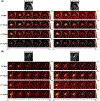Dual-phase imaging of cardiac metabolism using hyperpolarized pyruvate
- PMID: 34617626
- PMCID: PMC8616832
- DOI: 10.1002/mrm.29042
Dual-phase imaging of cardiac metabolism using hyperpolarized pyruvate
Erratum in
-
Erratum to: Dual-phase imaging of cardiac metabolism using hyperpolarized pyruvate (Magn Reson Med. 2022;87:302-311.).Magn Reson Med. 2022 Jun;87(6):3025-3026. doi: 10.1002/mrm.29146. Epub 2022 Feb 21. Magn Reson Med. 2022. PMID: 35188984 No abstract available.
Abstract
Purpose: Previous cardiac imaging studies using hyperpolarized (HP) [1-13 C]pyruvate were acquired at end-diastole (ED). Little is known about the interaction between cardiac cycle and metabolite content in the myocardium. In this study, we compared images of HP pyruvate and products at end-systole (ES) and ED.
Methods: A dual-phase 13 C MRI sequence was implemented to acquire two sequential HP images within a single cardiac cycle at ES and ED during successive R-R intervals in an interleaved manner. Each healthy volunteer (N = 3) received two injections of HP [1-13 C]pyruvate for the dual-phase imaging on the short-axis and the vertical long-axis planes. Spatial distribution of HP 13 C metabolites at each cardiac phase was correlated to multiphase 1 H MRI to confirm the mechanical changes. Ratios of myocardial HP metabolites were compared between ES and ED. Segmental analysis was performed on the midcavity short-axis plane.
Results: In addition to mechanical changes, metabolic profiles of the heart detected by HP [1-13 C]pyruvate differed between ES and ED. The myocardial signal of [13 C]bicarbonate relative to [1-13 C]lactate was significantly smaller at ED than the ratio at ES (p < .05), particularly in mid-anterior and mid-inferoseptal segments. The distinct metabolic profiles in the myocardium likely reflect the technical aspects of the imaging approach such as the coronary flow in addition to the cyclical changes in metabolism.
Conclusion: The study demonstrates that metabolic profiles of the heart, measured by HP [1-13 C]pyruvate, are affected by the cardiac cycle in which that the data are acquired.
Keywords: cardiac; dual-phase; end-diastole; end-systole; hyperpolarized pyruvate.
© 2021 International Society for Magnetic Resonance in Medicine.
Figures







References
-
- Sun W, Liu Q, Leng J, Zheng Y, Li J. The role of pyruvate dehydrogenase complex in cardiovascular diseases. Life Sci. 2015;121:97–103. - PubMed
-
- Hartvig P, Waldenström A, Wikström G, et al. The diabetic heart: a porcine model evaluated with positron emission tomography using 1-11C-palmitate and 3-11C-pyruvate. Diabetes Res. 1989;12(1):1–5. - PubMed
-
- Antoni G. Development of carbon-11 labelled PET tracers-radiochemical and technological challenges in a historic perspective. J Labelled Comp Radiopharm. 2015;58(3):65–72. - PubMed
Publication types
MeSH terms
Substances
Grants and funding
LinkOut - more resources
Full Text Sources
Research Materials
Miscellaneous

